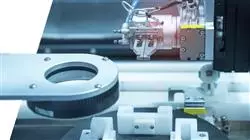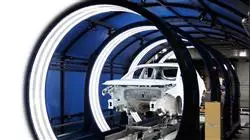University certificate
The world's largest faculty of information technology”
Introduction to the Program
Acquiring knowledge in quantum technologies at this time will make you a leader in programming in the near-term future”

Training a model from scratch implies having a large amount of previously catalogued information, approximately 10,000 photos of each of the types to be differentiated. This takes hours to achieve good results. In these cases, previously trained models can be used as a starting point, through the Transfer Learning resource. This Postgraduate diploma examines what network models are currently available to facilitate model training using this technique.
The graduate will analyze the main use cases that exist for computer vision: classification, object detection, object identification and object tracking. For example, Google uses these algorithms to be able to search from images. Facebook, for example, uses them to automatically identify and tag people in a photo.
Quantum computing has advanced rapidly in both theory and practice in recent years and, with it, the hope of potential impact on real applications. A key area of interest and where quantum computing is proving to be most efficient is in the field of Machine Learning and its application in real proactive, predictive and prescriptive problems.
This program analyzes in which situations a quantum advantage, in the context of advanced analytics and artificial intelligence, could be achieved for the engineering world. The objective of this Postgraduate diploma is to show what benefits current and future quantum technologies can provide to machine learning, focusing on algorithms that are challenging for classical digital computers, such as Kernel-based models, optimization and convolutional networks.
As it is a 100% online University Expert, the student is not conditioned by fixed schedules or the need to move to another physical location. Using a device with Internet access, you can consult the rich content that will help you acquire quantum computing techniques to reach the elite in the computer industry. All of this, at any time of the day, combining your work and personal life with your academic life at your own pace.
This training will allow you to advance in your career in a seamless way”
This Postgraduate diploma in Computer Vision and Quantum Computing the most comprehensive and up-to-date scientific program on the market. The most important features include:
- The development of case studies presented by experts in Computer Vision and Quantum Computing
- The graphic, schematic, and eminently practical contents with which they are created, provide practical information on the disciplines that are essential for professional practice
- Practical exercises, where the self-assessment process can be carried out to improve learning
- Its special emphasis on innovative methodologies
- Theoretical lessons, questions to the expert, debate forums on controversial topics, and individual reflection assignments
- Content that is accessible from any fixed or portable device with an Internet connection
You are facing an emerging market where getting the right knowledge and advice is going to be paramount in order to take advantage of evolutions”
The program’s teaching staff includes professionals from the sector who contribute their work experience to this training program, as well as renowned specialists from leading societies and prestigious universities.
The multimedia content, developed with the latest educational technology, will provide professionals with situated and contextual learning, i.e., a simulated environment that will provide immersive training, designed for training oneself in real situations.
This program is designed around Problem Based Learning, whereby the professional must try to solve the different professional practice situations that arise during the academic year. For this purpose, the student will be assisted by an innovative interactive video system created by renowned and experienced experts.
You will examine which network models are currently available to facilitate the training of your model, applying the Transfer Learning technique"

You will see the benefits that current and future quantum technologies can provide to machine learning, focusing on algorithms"
Why study at TECH?
TECH is the world’s largest online university. With an impressive catalog of more than 14,000 university programs available in 11 languages, it is positioned as a leader in employability, with a 99% job placement rate. In addition, it relies on an enormous faculty of more than 6,000 professors of the highest international renown.

Study at the world's largest online university and guarantee your professional success. The future starts at TECH”
The world’s best online university according to FORBES
The prestigious Forbes magazine, specialized in business and finance, has highlighted TECH as “the world's best online university” This is what they have recently stated in an article in their digital edition in which they echo the success story of this institution, “thanks to the academic offer it provides, the selection of its teaching staff, and an innovative learning method aimed at educating the professionals of the future”
A revolutionary study method, a cutting-edge faculty and a practical focus: the key to TECH's success.
The most complete study plans on the university scene
TECH offers the most complete study plans on the university scene, with syllabuses that cover fundamental concepts and, at the same time, the main scientific advances in their specific scientific areas. In addition, these programs are continuously being updated to guarantee students the academic vanguard and the most in-demand professional skills. In this way, the university's qualifications provide its graduates with a significant advantage to propel their careers to success.
TECH offers the most comprehensive and intensive study plans on the current university scene.
A world-class teaching staff
TECH's teaching staff is made up of more than 6,000 professors with the highest international recognition. Professors, researchers and top executives of multinational companies, including Isaiah Covington, performance coach of the Boston Celtics; Magda Romanska, principal investigator at Harvard MetaLAB; Ignacio Wistumba, chairman of the department of translational molecular pathology at MD Anderson Cancer Center; and D.W. Pine, creative director of TIME magazine, among others.
Internationally renowned experts, specialized in different branches of Health, Technology, Communication and Business, form part of the TECH faculty.
A unique learning method
TECH is the first university to use Relearning in all its programs. It is the best online learning methodology, accredited with international teaching quality certifications, provided by prestigious educational agencies. In addition, this disruptive educational model is complemented with the “Case Method”, thereby setting up a unique online teaching strategy. Innovative teaching resources are also implemented, including detailed videos, infographics and interactive summaries.
TECH combines Relearning and the Case Method in all its university programs to guarantee excellent theoretical and practical learning, studying whenever and wherever you want.
The world's largest online university
TECH is the world’s largest online university. We are the largest educational institution, with the best and widest online educational catalog, one hundred percent online and covering the vast majority of areas of knowledge. We offer a large selection of our own degrees and accredited online undergraduate and postgraduate degrees. In total, more than 14,000 university degrees, in eleven different languages, make us the largest educational largest in the world.
TECH has the world's most extensive catalog of academic and official programs, available in more than 11 languages.
Google Premier Partner
The American technology giant has awarded TECH the Google Google Premier Partner badge. This award, which is only available to 3% of the world's companies, highlights the efficient, flexible and tailored experience that this university provides to students. The recognition as a Google Premier Partner not only accredits the maximum rigor, performance and investment in TECH's digital infrastructures, but also places this university as one of the world's leading technology companies.
Google has positioned TECH in the top 3% of the world's most important technology companies by awarding it its Google Premier Partner badge.
The official online university of the NBA
TECH is the official online university of the NBA. Thanks to our agreement with the biggest league in basketball, we offer our students exclusive university programs, as well as a wide variety of educational resources focused on the business of the league and other areas of the sports industry. Each program is made up of a uniquely designed syllabus and features exceptional guest hosts: professionals with a distinguished sports background who will offer their expertise on the most relevant topics.
TECH has been selected by the NBA, the world's top basketball league, as its official online university.
The top-rated university by its students
Students have positioned TECH as the world's top-rated university on the main review websites, with a highest rating of 4.9 out of 5, obtained from more than 1,000 reviews. These results consolidate TECH as the benchmark university institution at an international level, reflecting the excellence and positive impact of its educational model.” reflecting the excellence and positive impact of its educational model.”
TECH is the world’s top-rated university by its students.
Leaders in employability
TECH has managed to become the leading university in employability. 99% of its students obtain jobs in the academic field they have studied, within one year of completing any of the university's programs. A similar number achieve immediate career enhancement. All this thanks to a study methodology that bases its effectiveness on the acquisition of practical skills, which are absolutely necessary for professional development.
99% of TECH graduates find a job within a year of completing their studies.
Postgraduate Diploma in Test-Driven Design
Test-driven design (TDD) is a software design technique that focuses on writing and running automated tests before code development. Basically, it means developing an application by testing every piece of code before writing any code. This approach to software development is an important practice within the Agile methodology.
The idea behind TDD is that if you structure each step the right way, you can predict the end results of the process. With this, developers can ensure that their code works even before they are ready to write the application in its entirety. With the guidance provided by continuous testing, they can ensure that each new iteration of code is working as expected, and does not contain bugs. This allows for more efficient and cost-effective development, and integrates quality and security from the beginning of the design phase.
The TDD process begins by creating an automated test to verify the expected behavior of a piece of code. Then, enough code is written to pass the test. The automated tests are then rerun to ensure that all tests have passed successfully. If the tests pass, the new piece of code is easily integrated into the system. If not, the necessary adjustment is made to the code to make it behave correctly. The process is repeated for each major piece of code, ensuring that all functionality is validated and tested throughout the development cycle. In this way, it becomes possible to document every part of the system or application before writing a single line of code.
TDD is a software design technique aimed at testing and creating high-quality, secure code. By structuring the design process in this way, developers can ensure that their code is robust, reducing costs and the amount of time required for software development, increasing its efficiency and adaptability.







